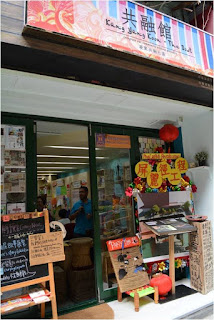Multiculturalism in
Action 2015-16
Pakistani Culture
Workshop: Making a Change for the Better
Session 3: Everyday
Life Challenges and Opportunities in the Neighborhood
Speakers:
Mr. Minhas Rashad and
Ms. Cecilia Tsui
(Services for Ethnic
Minorities, HKSKH Lady MacLehose Centre)
On 24 October, 2015,
participants of Pakistani Culture Workshop visited Kung Yung Koon – The Dost, and Ping Lai Path to explore the history and daily experiences of
the Pakistani community in Kwai Chung.
 |
| Presentations in Kung Yung Koon – The Dost (From left) Mr. Minhas Rashad, Ms. Cecilia Tsui and Prof. Tam |
Ms. Cecilia Tsui introduced the work of HKSKH Lady MacLehose Centre on cultural integration in the neighborhood around Ping Lai Path. One of the most important initiatives of the Centre was the opening of Kung Yung Koon – The Dost two years ago. Designed to be a community centre to bridge local Chinese and South Asian cultures, the Dost has organized exhibitions, guided tours, workshops, and music shows etc., and allowed the public to explore the uniqueness of different cultures.
 |
| Kung Yung Koon – The Dost |
Ms. Tsui also explained the revitalization project in Ping Lai Path that the Centre was responsible for. The project has aimed to improve the sitting-out area and to increase cross-cultural elements in the neighborhood. For instance, blessings in different languages would be used as decorations, emphasizing the importance of balancing the needs and interests of both Chinese and South Asian residents, as the community and its resources should be shared by all. It was hoped that this new public space could be enjoyed and shared by people from all cultural backgrounds, and would be a way to promote cultural integration.
Mr. Minhas Rashad continued the presentation with an introduction to the Indian, Nepali and Pakistani communities in Hong Kong, explaining to our participants the different religions and habits among different South Asian groups. Geographically speaking, the Pakistani population concentrated mostly in Yuen Long, Yau-Tsim-Mong, and Kwai Tsing districts. These districts provided less expensive housing and more job opportunities. The rapid industrial development in Kwai Chung in the 1970s attracted many Pakistani migrants to settle here for employment opportunities. Many Pakistani households have lived in Kwai Chung for more than 30 years.
The pressure of the Pakistanis in Hong Kong did not only come from learning Cantonese, Mr. Rashad said, as they usually needed to learn six to seven languages. Apart from English and Cantonese for basic communication, a Pakistani need to learn Arabic for reading Quran, and Urdu or a local dialect such as Punjabi for communication within the ethnic group. Some kids also learned French or Spanish in school as a second language to meet school requirements.
 |
| Learning to say hello with Pakistanis |
Mr. Rashad then showed us some Pakistani clothes and our participants had a chance to try wearing them. One characteristic feature of Pakistani clothing was not to show one’s body shape and not to expose too much of one’s body.
 |
| Our participant wearing hijab |
In everyday life, Mr. Rashad told us, it has been a challenge for Muslims to identify halal food and products in non-Islamic states. However, with more than ¼ of the world population being Muslims, more companies had applied for their products to be halal certified. “Halal” did not only apply to fresh meat or restaurants, as we would find lots of daily necessities and food, such as toothpastes and potato chips, sold with halal certification. The Ng Fung Hong Limited as the largest supplier of fresh meat in Hong Kong, for instance, had an employee specialized in slaughtering halal meat for Muslims in Hong Kong.
Pakistanis
loved cricket, said Mr. Rashad. Yet cricket in Hong Kong had remained an
elite sport and many Pakistani cricket lovers could not afford to rent cricket
fields or become members of the Hong Kong Cricket Club. The most common way for
Pakistani youth to enjoy cricket was to find a playground in their neighborhood
and play with simple kits.
 |
| Mr. Rashad showing the cricket bat |
In the guided tour, we visited a Pakistani grocery and learned about some products such as biscuits, mango juice, spices and henna, which were very popular among Pakistani as well as Chinese customers. We also learned that the mode of business in which these ethnic stores operated was quite different from Chinese stores, as Pakistani families would buy in bulk so home delivery service was essential. Monthly credit was also an important feature in the business.
 |
| Shopping in a Pakistani grocery |
We then enjoyed masala tea and some snacks in a restaurant owned by a Pakistani man and his Chinese wife. Our participants continued the discussion about religion and marriage actively while enjoying afternoon tea.
 |
| Discussion in the halal restaurant |
One important point we discussed was the small-scale mosque located in a flat in Ping Lai Path. As Mr. Rashad explained, the mosque was supported by the Pakistani community nearby, whose donations helped to pay the rent and the salary of the Imam. As bigger mosques in Hong Kong were located in Kowloon, Wan Chai, Central, Stanley, and Chai Wan, Mr. Rashad said these were too far away for the Muslim children here, as they had to travel after school to learn the Quran. That was the reason why the Pakistanis in Kwai Chung decided to run a mosque as a way to meet the needs of the Muslims in this district.
 |
| Pakistani children in the neighborhood, after their Quran lesson in the mosque |
Participants had a lot
to take home after this seminar – not only information and insiders’
perspectives on life as an ethnic minority here, but also fond memories of the
great-tasting snacks: pakora, aloo naan, chicken masala, and milk tea. Yum!
 |
| Pakora, chicken masala, and aloo naan |
No comments:
Post a Comment